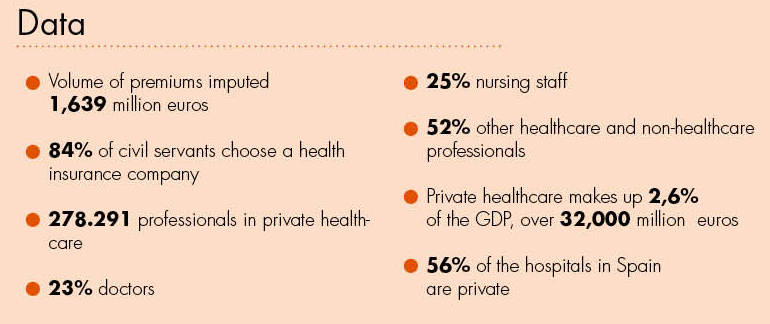
Mutual societies, a key partner for global healthcare
Over 80% of civil servants choose private healthcare, which looks after 1.8 million public workers in Spain with a cost that is 33% less.
Private healthcare is a good partner for the public and the collaboration is efficient. An example of this is the administrative mutualism, which allows civil servants to choose if they want the care provided for them is given by the National Health System or a private insurance company. 84% of civil servants choose the second option.
In 1975 Muface (Mutualidad de Funcionarios Civiles del Estado – Mutual Society of State Civil Servants) which, along with Isfas (Instituto Social de las Fuerzas Armadas – Social Institute of the Armed Forces) and Mugeju (Mutualidad General Judicial – General Judicial Mutual Society), make up the managing bodies of the administrative mutualism and they sign agreements with insurance companies. The system looks after 1.8 million people; 65% of them covered by the mutual society of civil servants, Muface; 31% by the mutual society of the Armed Forces and 4% by the judicial society, Mugeju.
The public-private collaboration in healthcare, but also in other areas such as education, has a series of advantages such as the optimization of the financial efficiency of the economic effort of the administrations and the mobilization of all the available resources. But they also generate confidence in the citizens, who can choose. The 2008 financial crisis and the Covid-19 pandemic were two examples of resilience for this collaboration and a unique opportunity to rebuild and reconsider the Welfare State. Healthcare is facing up to crucial challenges such as the ageing of the population, the personalization of medicine and digitalization. According to the latest report by the Instituto para el Desarrollo e Integración de la Sanidad – IDIS (Institute for the Development and Integration of Healthcare), 78% of citizens consider that Spanish healthcare needs an adaptation effort to face up to the new health challenges and 82.4% believe that the latest technological and digital innovations should be incorporated into all the health processes.
Most of healthcare expenditure occurs at the end of life, today’s serious diseases are chron,ic and life expectancy is increasing. Many people cannot keep up with the premiums, therefore one solution would be to create group insurance policies such as the Muface model. A successful model that has taken private healthcare to many cities in Spain.
According to data from IDIS, the number of members of mutual societies in recent years is showing a decreasing trend, with a drop of over 1% since 2016. Figures that could change with the incorporation of new civil servants to the system after the Government’s call for new employees. Added to this drop is the increase in the average age of the users, which implies more claims. “This fact, along with the rising cost of the service and the inclusion of new services, make the sustainability of the model more difficult, given that the claims are approaching or are over 100% at times,” sources from IDIS warn.
For 2021, they have budgeted 2,312 million euros for administrative mutualism, a 2.8% increase compared to the previous year, while healthcare expenditure, in the General Budget of the State 2021, has increased by 10%, compared to 2019. And this is ins spire of the fact that administrative mutualism means an estimated saving by the Administration of 451 euros per member of a mutual society, as the expense generated is 33% lower. Accordingly, “it is estimated that Muface’s average premium in 2020 reached 917 euros/year per insured party, while the public healthcare expenditure per capita for this same year was 1,368 euros (without included pharmaceutical costs or the expense to be paid to mutual societies)” according to IDIS.
Concerned about healthcare
On the other hand, according to the latest report by the IDIS Foundation, from May, 2021, four out of every five Spaniards would increase the entry devoted to healthcare, regardless of which cover is in question, and 71.5% consider that healthcare in Spain is not correctly funded. Additionally, over 75% of those surveyed consider the cooperation between private and public healthcare to be necessary or very necessary and the positive perception regarding this last point rises from 6.39 in 2020 to 6.67 this year.
Spain is one of the countries where private healthcare expenditure is highest (29.2%), above that of countries in the OECD (23.3%) and it reached 32,750 million euros in 2019, 2.6% of the GDP. Spain has 9.2 million insured parties, without counting members of the mutual societies, who contribute to the saving of 1.368 euros per patient by the public system, according to the report. And in the case of a patient who uses a mixed form of healthcare, using both public and private, the saving would be 506 euros.




